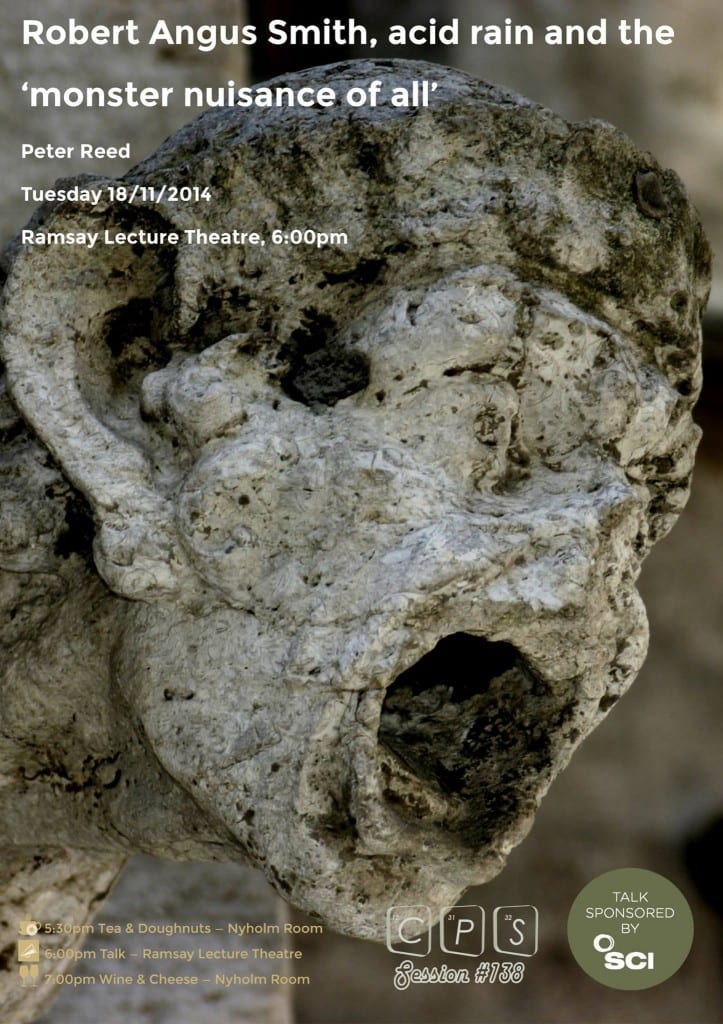Robert Angus Smith, Acid Rain and the ‘Monster Nuisance of it All’: CPS talk – 18/11/14
By Penny Carmichael, on 20 November 2014
-Article by Stephen Leach
This week the CPS-ers were delivered a portrait of Robert Angus Smith, courtesy of independent researcher and science historian Peter Reed. Robert Angus Smith is credited to be the first person to use the term ‘acid rain’ and he was one of the first people to straddle the political scientific divide. In the nineteenth century, new industries brought new pollutants and health risks, so legislators began enforcing safe practise on the industrialists for the benefit of the workers, the public and the environment. At the centre of this was Robert Angus Smith.
Circa 1840, Darwin’s ‘Origin’ was yet to be published, the laws of thermodynamics were driving the emerging industrial revolution and an atom had yet to be defined. New scientific ideas were pervading all arenas of life and like all young men of sound mind and good prospects, Smith was torn between an education in science or religion. He chose chemistry and was educated in Giessen, Germany, under Justus Von Liebig, a pioneering educator of the sciences. With the emergence of a technical society, its associated problems were increasingly being found on the desks of the professional scientists. With regards to pollution and safety, the government was keen to put the onus of responsibility on the capitalists but still required legislation overseen with some scientific expertise.
Industries manufacturing glass, paper, textiles and soap all required a supply of ‘soda’, Na2SO4. It had long been harvested from natural resources, but the demand was increasing largely. The Leblanc batch process was a means to chemically synthesise soda in tonnage quantities from rock salt and sulphuric acid. Along with a viscous sulfur pollutant called ‘Galligu’, (which was liberally thrown over the land around the factories of Widnes, Runcorn and St Helens), was a more immediately troublesome substance: HCl gas. Around 250,000 tonnes per year were entering the atmosphere.
In 1863, ‘The Alkali Inspectorate’ was established with Smith at the helm. Policy makers were aware of the dangers of HCl and they set out to curb emissions by 95%. This was achieved by the invention of the acid tower by a Lancashire manufacturer, William Gossage. The problem was circumvented somewhat; emissions were cut by dissolving 95% of the gas in water. The gas was passed over huge arrays of wet obsidian bricks and it would dissolve into the water. Smith was tasked with visiting factories and ensuring that targets were being met. Here we learnt of an amazing device called the ‘Compound Self Acting Aspirator’. Since the inspectors could not be everywhere at once and the capitalists could not be trusted unconditionally, this device would periodically collect samples of the gas output to ensure that the plant was law abiding, these samples could then be collected later and analysed in a lab. Overall, air quality greatly improved but this was at the expense of the waterways into which the dissolved HCl would flow.
Smith went on to be Head Inspector for River Pollution in addition to his existing responsibilities. His scientific background and government association made him a prototype of the numerous advisors that today consult world governments on policy. The centralised regulation of industries is commonplace now and much of the good practise of UK industry and environmental protection has its origin in the Alkali Inspectorate, which by 1956 covered 1,794 chemical processes. It is a situation still highly relevant today; novel industrial processes must be subject to legislation, ‘fracking’ in the UK being a good example.
Smith‘s lifetime coincided with a dynamic time for the role of the scientist in the UK; a respectable profession it had become. Materialist philosophies were challenging religious conservatism and the momentum of today’s technological culture was building. At a glance life may seem different today but we are still part of the epoch which was burgeoning at that time.
 Close
Close



 Subscribe to this blog!
Subscribe to this blog!